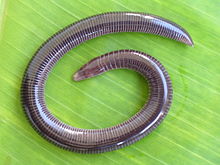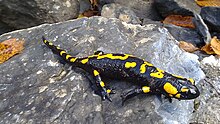42:
88:
276:
63:
208:. A close relationship between salamanders and caecilians is a competing hypothesis to the more widely supported view that salamanders and frogs are each other's closest relatives within a clade called
317:
231:"A large-scale phylogeny of Amphibia including over 2800 species, and a revised classification of extant frogs, salamanders, and caecilians"
310:
212:. Procera was proposed as a clade in 1998 and has been supported by few recent morphological and molecular studies.
87:
341:
303:
41:
336:
82:
252:
287:
242:
49:
70:
275:
330:
28:
139:
62:
247:
230:
170:
197:
283:
209:
201:
193:
129:
99:
256:
119:
32:
175:
109:
189:
205:
291:
311:
8:
318:
304:
61:
40:
20:
246:
221:
235:Molecular Phylogenetics and Evolution
7:
272:
270:
229:Pyron, A. R.; Wiens, J. J. (2011).
290:. You can help Knowledge (XXG) by
14:
274:
86:
1:
248:10.1016/j.ympev.2011.06.012
358:
269:
167:
162:
83:Scientific classification
81:
69:
60:
48:
39:
23:
54:Uraeotyphlus interruptus
157:Feller and Hedges, 1998
286:-related article is a
75:Salamandra salamandra
16:Clade of amphibians
188:is a hypothetical
299:
298:
183:
182:
158:
349:
320:
313:
306:
278:
271:
261:
260:
250:
226:
156:
91:
90:
65:
50:Kerala caecilian
44:
27:Temporal range:
21:
357:
356:
352:
351:
350:
348:
347:
346:
342:Amphibian stubs
327:
326:
325:
324:
267:
265:
264:
228:
227:
223:
218:
155:
85:
71:Fire salamander
35:
25:
17:
12:
11:
5:
355:
353:
345:
344:
339:
329:
328:
323:
322:
315:
308:
300:
297:
296:
279:
263:
262:
241:(2): 543–583.
220:
219:
217:
214:
196:that includes
181:
180:
179:
178:
173:
165:
164:
160:
159:
150:
143:
142:
137:
133:
132:
127:
123:
122:
117:
113:
112:
107:
103:
102:
97:
93:
92:
79:
78:
67:
66:
58:
57:
46:
45:
37:
36:
26:
15:
13:
10:
9:
6:
4:
3:
2:
354:
343:
340:
338:
335:
334:
332:
321:
316:
314:
309:
307:
302:
301:
295:
293:
289:
285:
280:
277:
273:
268:
258:
254:
249:
244:
240:
236:
232:
225:
222:
215:
213:
211:
207:
203:
199:
195:
191:
187:
177:
174:
172:
169:
168:
166:
161:
154:
151:
148:
145:
144:
141:
138:
135:
134:
131:
128:
125:
124:
121:
118:
115:
114:
111:
108:
105:
104:
101:
98:
95:
94:
89:
84:
80:
76:
72:
68:
64:
59:
55:
51:
47:
43:
38:
34:
30:
29:Late Triassic
22:
19:
292:expanding it
281:
266:
238:
234:
224:
185:
184:
152:
146:
140:Lissamphibia
74:
53:
18:
198:salamanders
171:Gymnophiona
337:Amphibians
331:Categories
216:References
202:caecilians
194:amphibians
136:Subclass:
284:amphibian
210:Batrachia
106:Kingdom:
100:Eukaryota
257:21723399
204:but not
130:Amphibia
120:Chordata
116:Phylum:
110:Animalia
96:Domain:
33:Holocene
186:Procera
176:Caudata
163:Orders
153:Procera
126:Class:
24:Procera
255:
282:This
206:frogs
190:clade
147:Clade
288:stub
253:PMID
200:and
243:doi
192:of
333::
251:.
239:61
237:.
233:.
149::
77:)
56:)
31:-
319:e
312:t
305:v
294:.
259:.
245::
73:(
52:(
Text is available under the Creative Commons Attribution-ShareAlike License. Additional terms may apply.
↑

